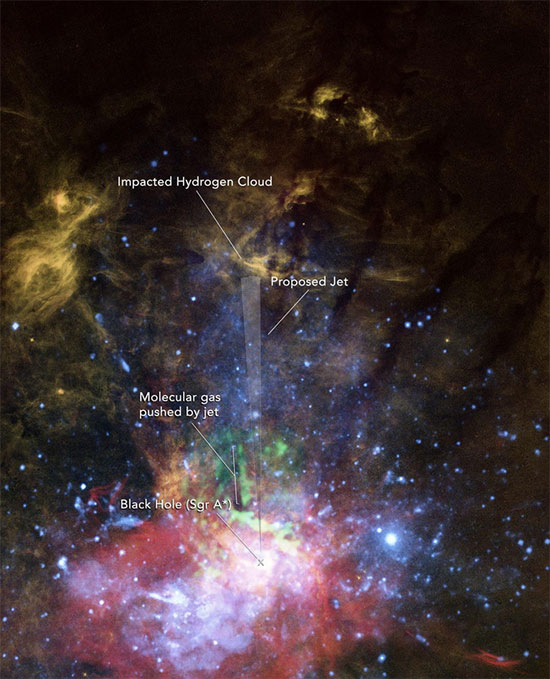Scientists have found evidence that the monster sleeping at the center of the Milky Way galaxy has unexpectedly awakened multiple times, devouring many stars without anyone noticing.
Sagittarius A* (Sgr A*) is a supermassive black hole, often referred to by astronomers as a “monster black hole,” weighing in at 4 million times the mass of the Sun and believed to have been in a deep slumber for many years. However, there is increasing evidence of mysteriously missing stars and gas clouds near it.
A new study published in the Astrophysical Journal, from NASA’s Space Telescope Science Institute, has captured mysterious beams of deadly radiation that this monster black hole occasionally emits, radiating in a hourglass shape above and below the galactic plane containing Earth.

This composite image shows yellow representing hydrogen clouds observed by Hubble, blue representing data from Chandra, green from ALMA, and red from LVA. A faint white column marks the jet stream emitted by the black hole after consuming material – (Photo: NASA/ESA/Cecil/STScI)
According to SciTech Daily, these terrifying plasma beams heat the gas outside the galactic plane, creating gamma rays and X-rays that Earth-based telescopes have captured.
Among the evidence, the most striking is an image taken by the Hubble Space Telescope (NASA/ESA) showing a bright gas knot affected by an invisible jet stream from the black hole.
The authors state that during the early days of the Milky Way, this central black hole shone brightly like a quasar (appearing as a star in the sky, but not actually a star) due to the radiation it emitted while consuming matter.
Currently, the black hole sleeps most of the time but still wakes up regularly to snack on any unfortunate objects that wander too close. According to astronomer Geral Cecil from the University of North Carolina, a member of the research team, the aforementioned evidence was also cross-referenced with an active monster black hole in the galaxy NGC 1068, located 47 million light-years from Earth.
In the most recent intense “feeding” event, estimated to have occurred 2-4 million years ago, our monster black hole generated enough energy to create two massive gamma-ray bubbles detected by NASA’s Fermi Gamma-ray Space Telescope in 2010, surrounded by two X-ray bubbles discovered by the ROSAT satellite in 2003.


















































